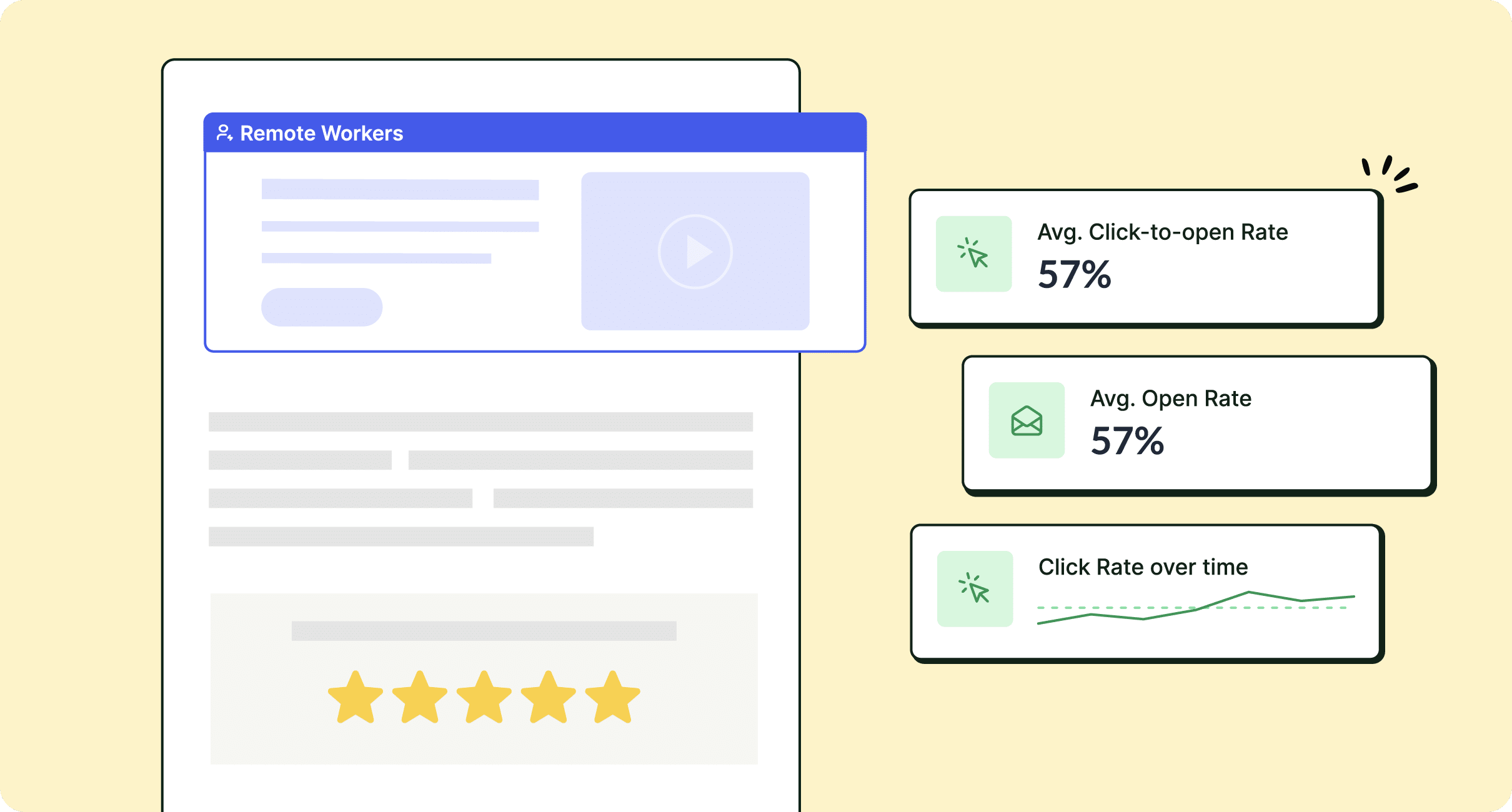The better your employee email engagement, the more united your organization can become. If you’ve been looking for ways to improve internal email engagement and start hitting your goals, we’ve rounded up the 15 best practices.
Improving internal email engagement isn’t always straightforward. Many organizations struggle with internal email engagement rates because employees feel overwhelmed by their inboxes or the content they receive is not personalized or relevant. This is exactly why crafting an employee engagement strategy for email is essential to cutting through the clutter and having your messages acted upon.
If your goal is increasing internal email engagement, you need to consider multiple tactics, from writing compelling subject lines to segmenting your distribution lists.
In this article, we uncover 15 practical methods for improving internal email engagement rates. We’ll also touch on the importance of email engagement and how to measure internal email engagement effectively. See how you can improve email engagement using ContactMonkey’s internal email platform.
Take a self-guided tour of ContactMonkey
See how our key features can streamline your internal communications.
Take product tour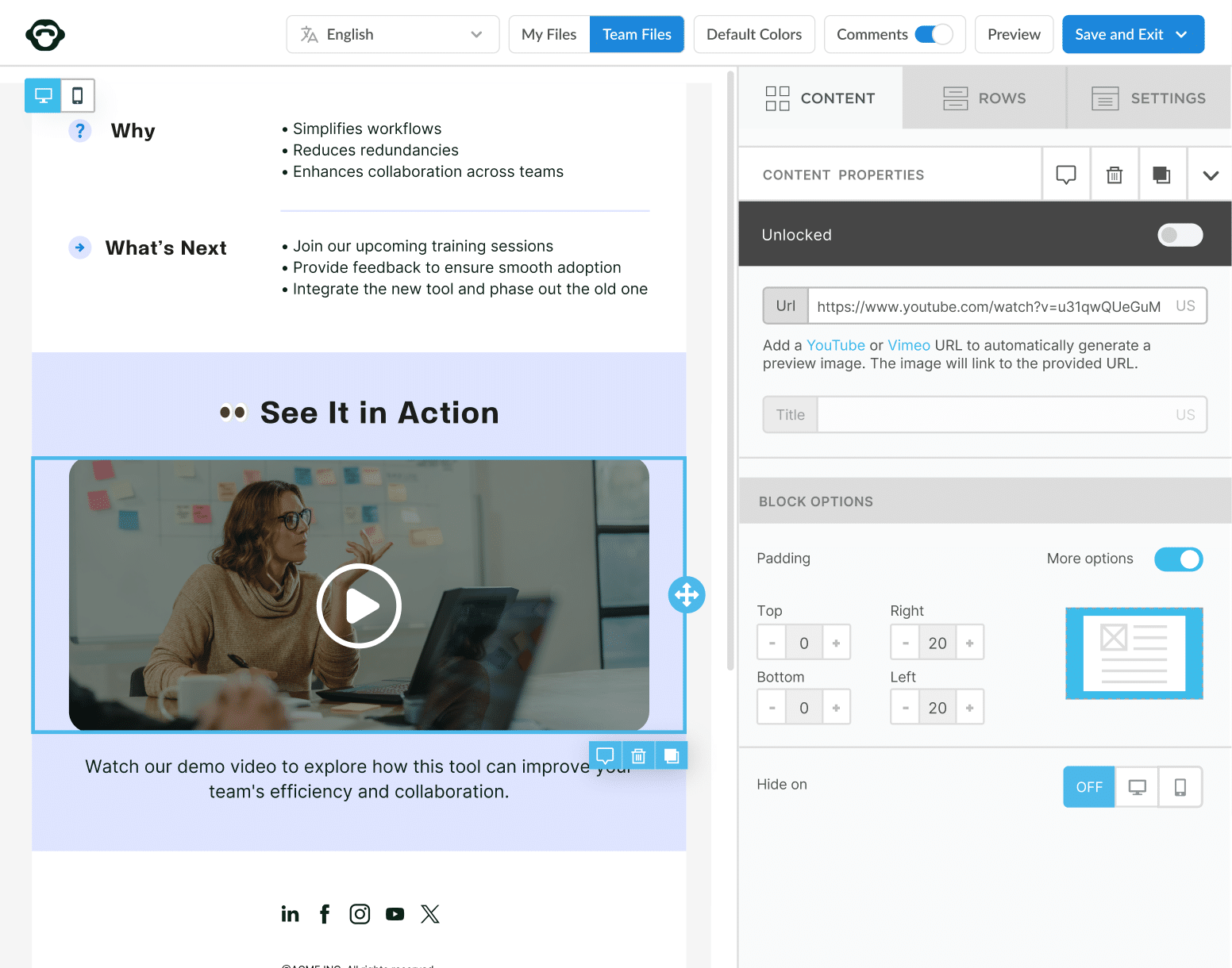

What is Email Engagement?
Email engagement refers to how recipients interact with your emails. It is typically measured by factors such as open rates, click-through rates, and actions taken after reading. In an internal communications context, email engagement looks at how employees respond to internal messages. For example, do your employees open emails quickly, click on embedded links, or perform requested tasks? Employee email engagement indicates the value and effect your communications are having on your team.
5 Reasons to Improve Internal Email Engagement
Focusing on improving internal email engagement rates is critical for several reasons:
- Faster decision-making: When employees open and read your messages quickly, they can respond and make decisions faster.
- Stronger alignment: High employee email engagement helps ensure everyone is on the same page regarding company goals, updates, and procedures.
- Increased productivity: Well-crafted internal emails reduce confusion and time spent sorting through irrelevant information, letting employees concentrate on their actual tasks.
- Employee satisfaction: An effective employee email strategy can boost overall morale by making employees feel heard and informed.
- Better collaboration: If emails are engaging and clear, teams collaborate more effectively, leading to smoother workflows and better project outcomes.
🎁BONUS: After you start your internal email engagement-boosting journey, consider diving deeper into internal email reports. A solid understanding of the email data will go a long way!
Start two-way conversations and employee feedback loops
Learn how to engage staff with pulse surveys, content ratings and reactions, custom polls, and more. Ready to send modern emails?
See engagement features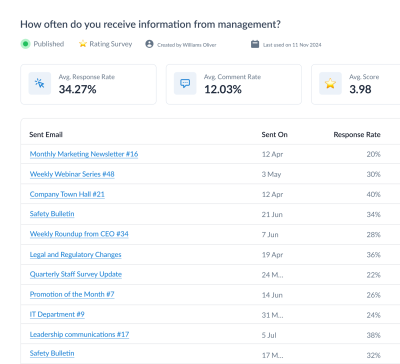
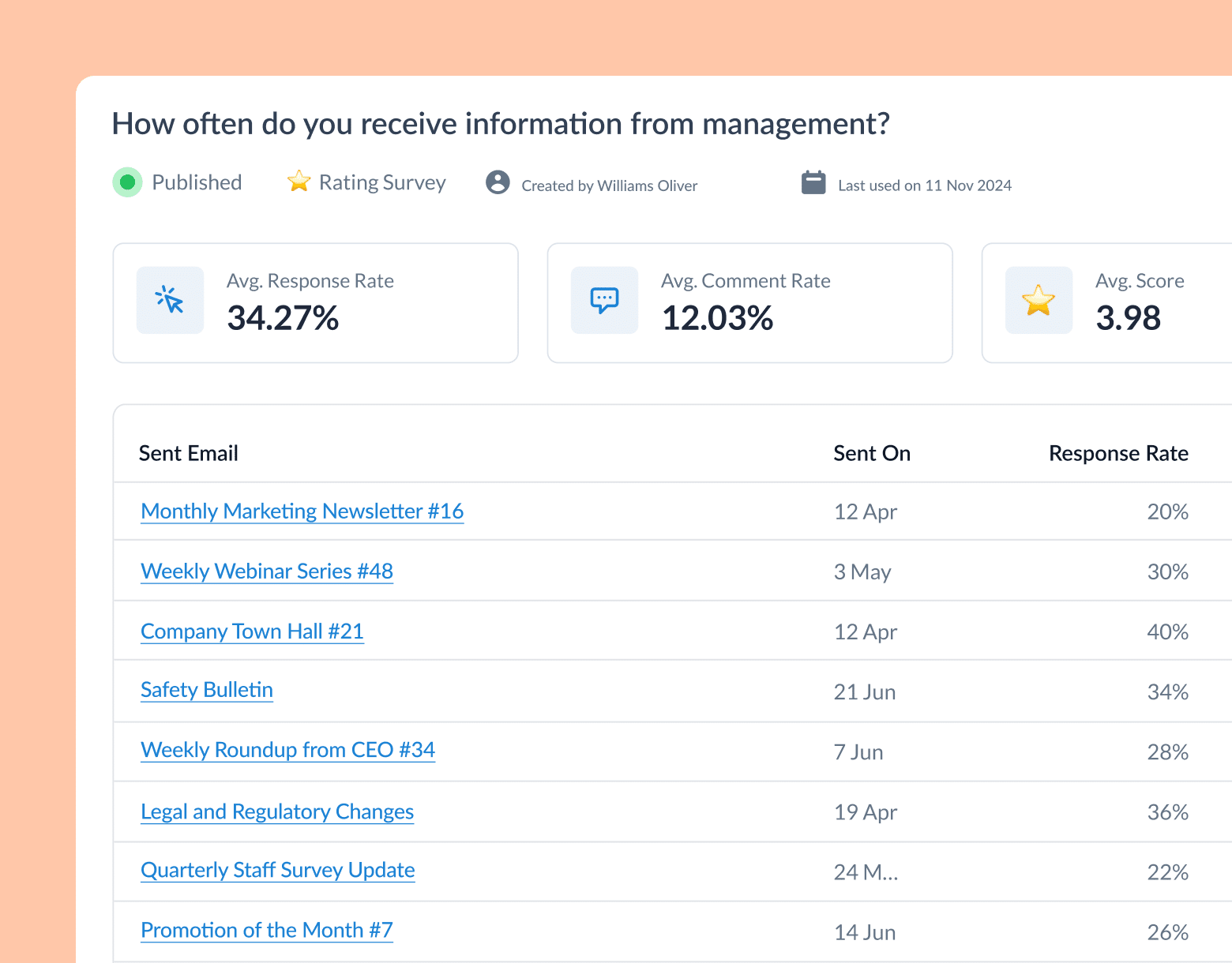
15 Best Ways to Increase Employee Email Engagement
Below, you’ll find 15 best ways to increase employee email engagement, each designed to capture attention, encourage action, and help you communicate more effectively.
1. Group your employees into specific segments
One of the most powerful methods for improving internal email engagement is through audience segmentation. Rather than sending the same email to everyone, break your team down into focused groups based on roles, departments, or projects. This is also one of the key reasons to use segmented email lists, answering the overall question “Why use internal email lists?”.
Why it works to improve internal email engagement: Relevance is key. When emails match an employee’s job function and interests, your internal email engagement rates naturally go up.
Tips to execute:
- Identify the top-level categories in your organization (e.g., HR, Marketing, Product, Sales).
- Collect data on who needs which types of updates.
- Create an employee email engagement strategy that includes these segments.
Actionable example: Send policy updates only to the HR and finance segments, while marketing campaigns or product roadmaps go to their respective teams.
Considerations: Be mindful of overlaps. Some employees might belong to multiple segments (e.g., a sales manager might also be part of the Leadership team).
🐒 PRO TIP: ContactMonkey allows you to create highly specialized mailing lists and segments based on role, location, or team via our list management feature. Plus, our newly launched Dynamic Content feature allows you to send personalized content to varying segments!
2. Use concise, compelling subject lines
Your subject line can make or break employee email engagement. Aim for concise yet intriguing phrasing that compels team members to open your emails immediately.
Why it works to improve internal email engagement: The subject line is your first impression. Catchy, relevant subjects cut through inbox clutter and prompt higher open rates.
Tips to execute:
- Keep subject lines under 50 characters.
- Use action verbs or numbers (e.g., “3 Quick Ways to Make Reporting Easier”).
- Avoid spammy language like “Urgent!!!” or excessive punctuation.
Actionable example: Instead of “Reminder: Submit Timesheets,” try “2 Days Left: Log Your Hours to Secure Payday.”
Considerations: Always deliver on your subject line’s promise. Misleading subject lines damage trust and reduce internal email engagement over time.
🎁BONUS: Follow our best email subject line tips and tricks to master the art of writing subject lines!
Create internal emails that get opened and read
No design or technical expertise needed. Save time, increase engagement, and dazzle your employees with fun and interactive communications.
Explore email features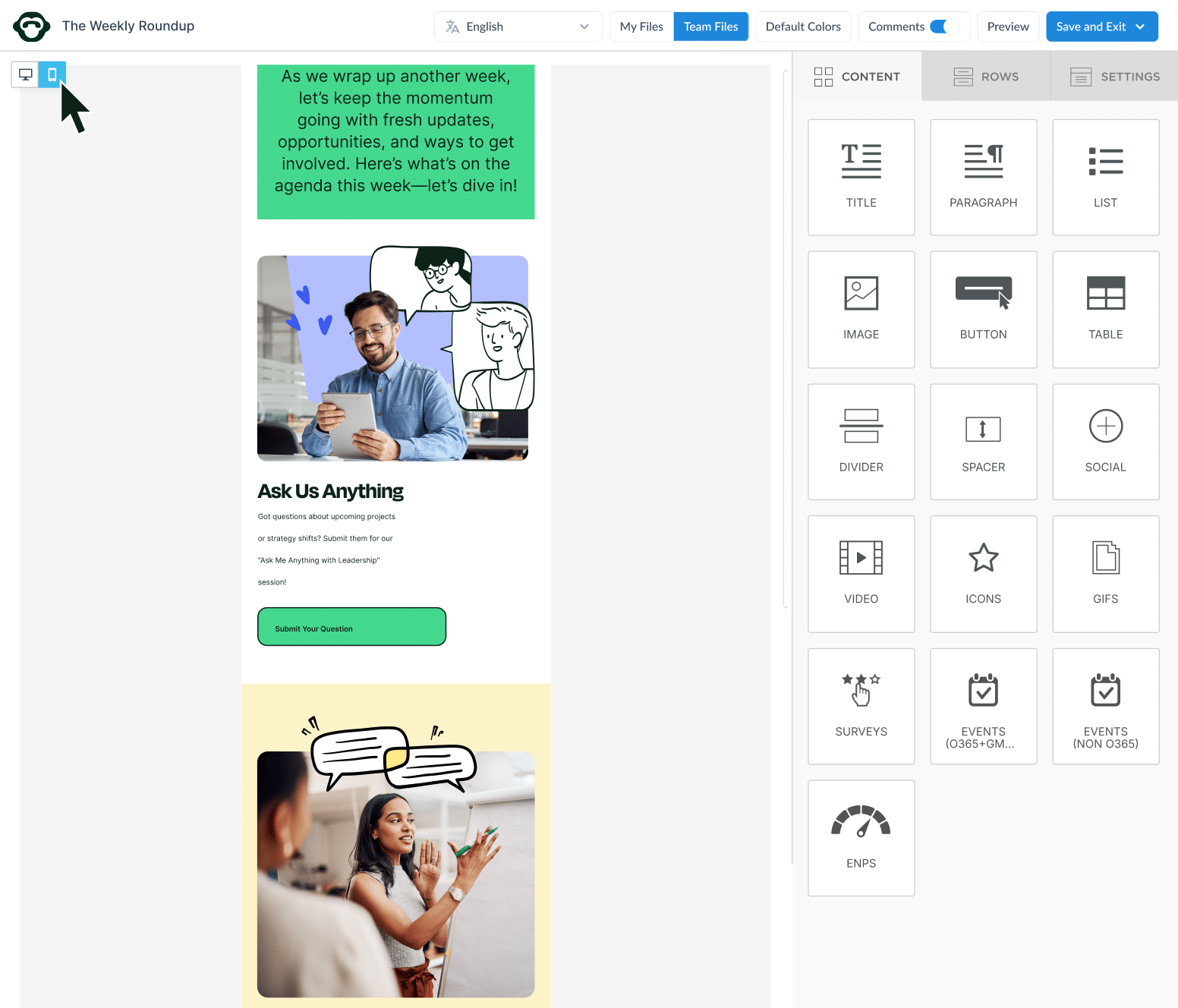
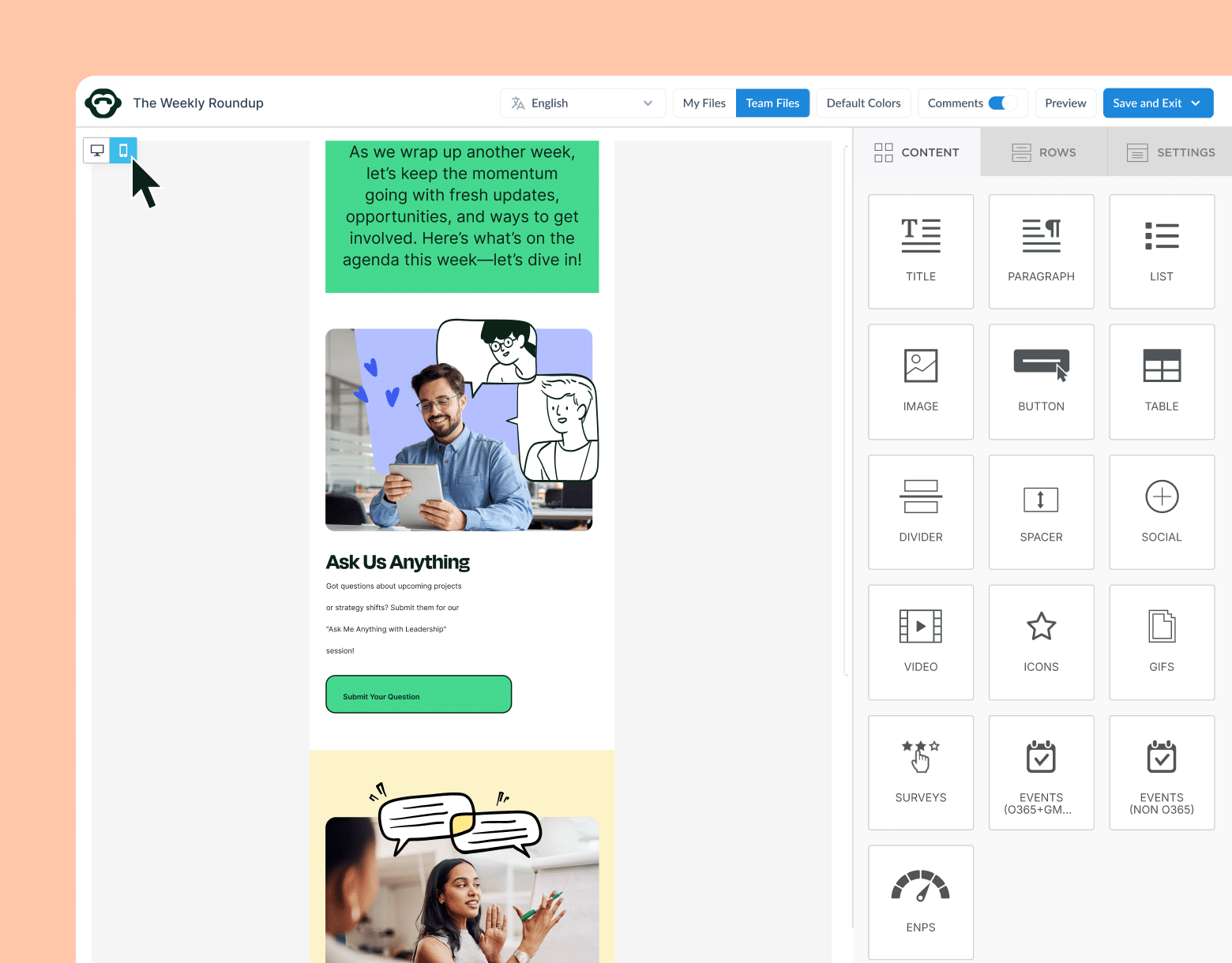
3. Personalize your messaging
Personalization in internal emails goes beyond just adding someone’s name. Tailor content to each department’s challenges, reference specific team wins, or highlight upcoming goals relevant to each recipient.
Why it works to improve internal email engagement: Employees feel recognized as individuals rather than just another address on your list. This boosts morale and encourages interaction.
Tips to execute:
- Set up custom fields for name, role, or department in your employee engagement email template.
- Send targeted success stories or product updates to relevant teams only.
- Consider adding personal notes or a “shout-out” section in each email.
Actionable example: A personalized subject line might read: “HR Team: Important Benefit Updates & Your Department’s Next Steps.”
Considerations: Always ensure you have correct data. Outdated or incorrect personalization can hurt employee email engagement.
🎁BONUS: For more on personalization, read our article on how to send personalized email.
4. Make your calls to action crystal clear
Strong calls to action (CTAs) significantly increase internal email engagement. If you need recipients to register for training, complete a survey, or attend a meeting, make your CTA obvious and compelling.
Why it works to improve internal email engagement: Clear CTAs guide employees on what to do next. This reduces confusion and boosts overall compliance or participation.
Tips to execute:
- Use bold buttons or colorful links.
- Keep CTA text action-focused (e.g., “Join Now,” “Learn More,” “Complete Survey”).
- Place the CTA above the fold in your email and possibly repeat it at the bottom.
Actionable example: “Complete Your Q2 Feedback Form” in a bright, standout button encourages immediate clicks, increasing results.
Considerations: Avoid multiple CTAs that could overwhelm or confuse employees. Prioritize one primary CTA per email if possible.
5. Optimize for mobile
A large portion of your workforce may check emails on the go. Designing messages that are mobile-friendly improves readability and boosts employee email engagement.
Why it works to improve internal email engagement: An email that’s difficult to view on a smartphone will be skipped or deleted, hurting your internal email engagement rates.
Tips to execute:
- Use responsive email templates that adapt to screen size.
- Keep images lightweight for quick loading.
- Ensure buttons and links are spaced for easy tapping.
Actionable example: Provide short, mobile-responsive videos for internal communications (specifically, training) that employees can watch on their phones during breaks.
Considerations: Test across multiple devices (Android, iOS, tablets) to ensure consistent user experience.
🐒 PRO TIP: ContactMonkey’s drag-and-drop employee email template builder offers mobile-responsive designs, ensuring you’re always improving internal email engagement rates no matter which device your employees use.
Organize your contacts with list management
Save time managing employee lists by syncing everything in one place.
Learn more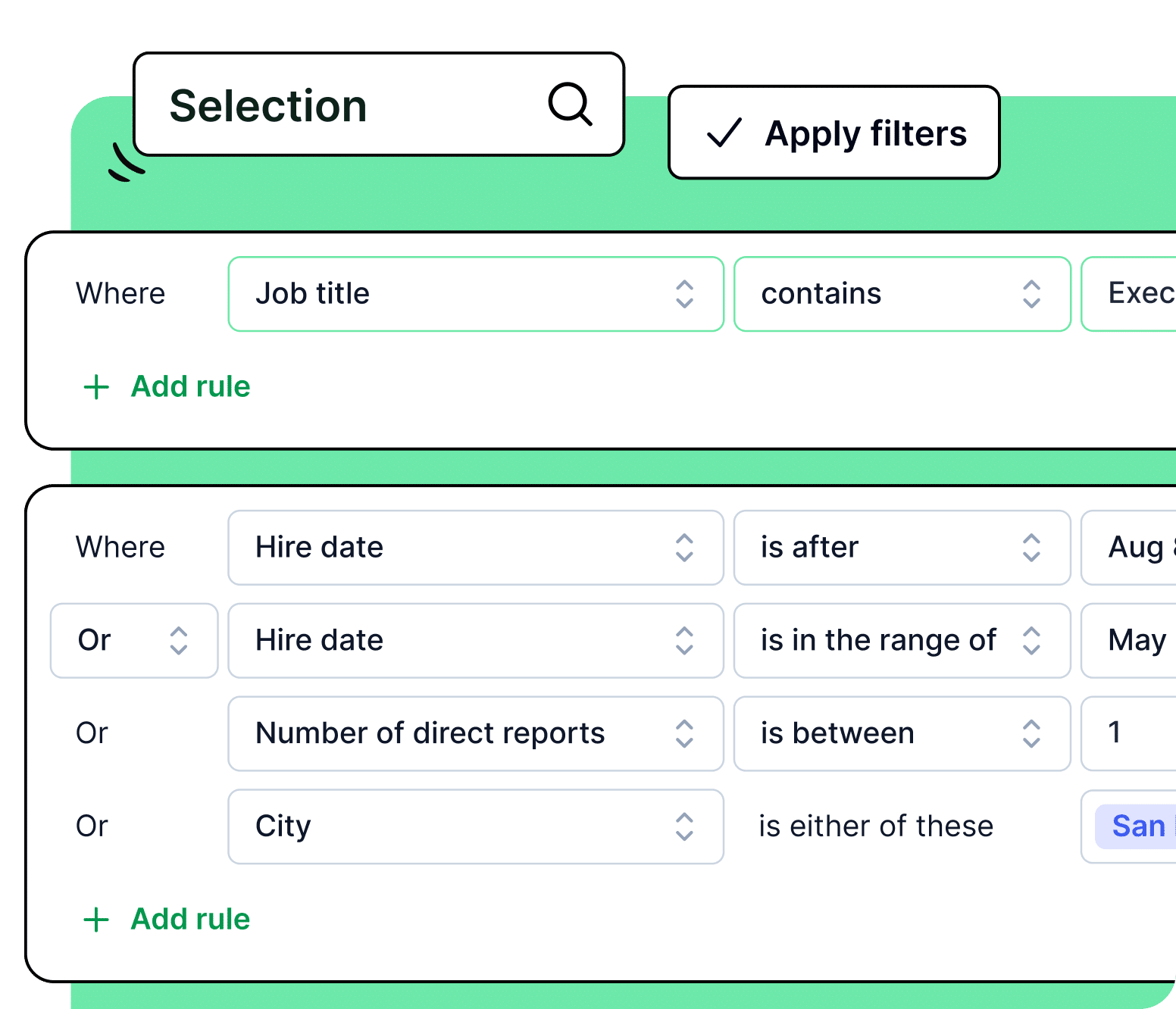
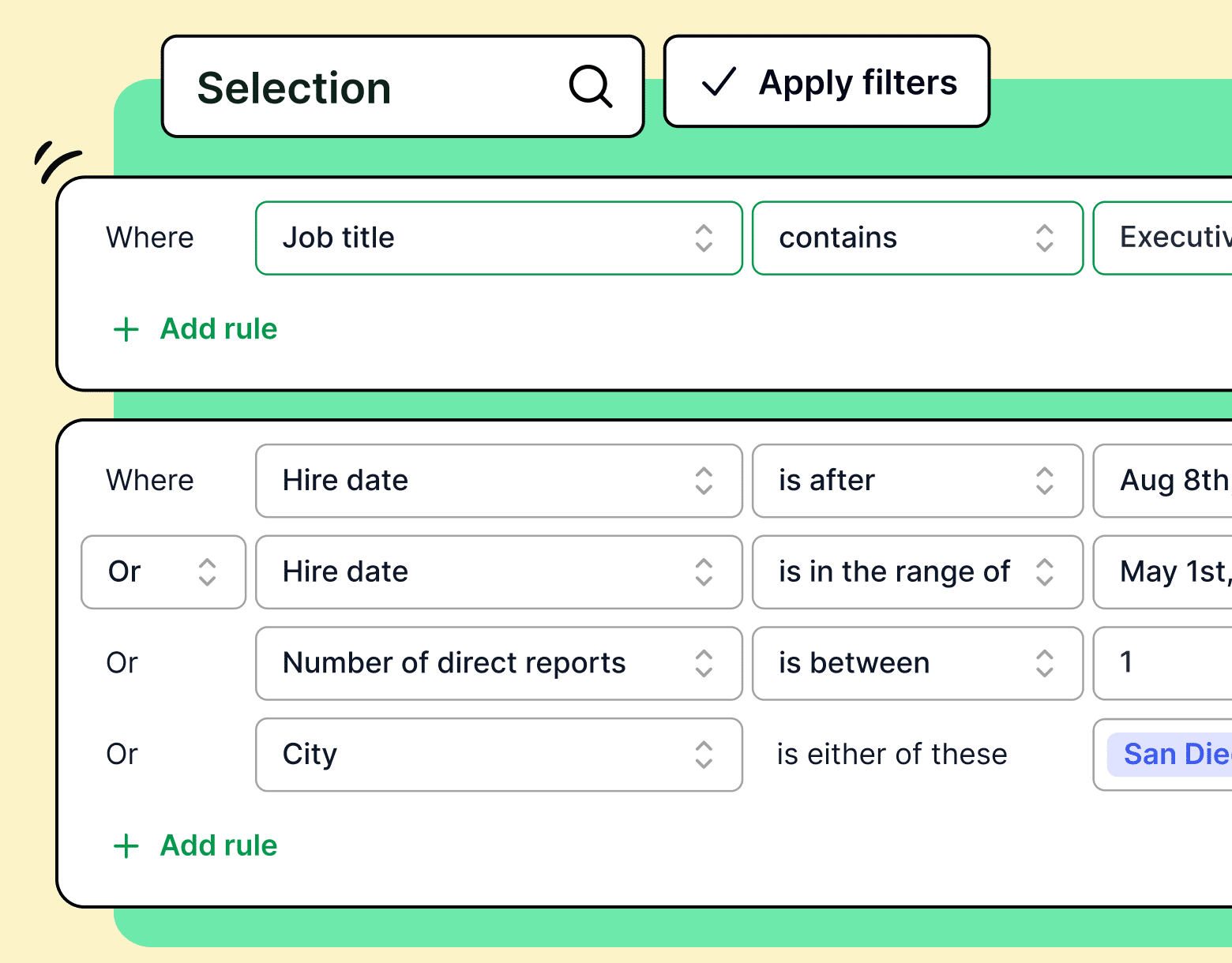
6. Clean and update your distribution lists
Keeping your email lists fresh and accurate is essential for an effective employee email engagement strategy. Inactive or outdated contacts bring down open rates and skew analytics.
Why it works to improve internal email engagement: Sending emails to the right, active recipients drives higher engagement and reduces wasted resources.
Tips to execute:
- Conduct quarterly or biannual list reviews.
- Remove or update emails of employees who’ve changed roles or left the company.
- Segment newly onboarded employees into relevant groups.
Actionable example: After a reorganization, reassign team members to updated email lists so they only receive pertinent communications.
Considerations: Be mindful of privacy regulations and employee data handling. Keep your processes transparent and compliant.
7. Conduct A/B tests on key email elements
Test different subject lines, layouts, or CTA buttons to see what resonates most with employees.
Why it works to improve internal email engagement: A/B testing removes the guesswork. Data reveals which version leads to better open rates, clicks, and overall employee email engagement.
Tips to execute:
- Change one element at a time (e.g., subject line).
- Split your audience randomly.
- Compare results and implement the winner in future internal email engagement campaigns.
Actionable example: Test sending an “All-Hands Meeting Reminder” email at 9 AM vs. 2 PM to see which timing garners the highest open rates.
Considerations: Avoid over-testing. If you constantly test multiple elements, it can be hard to isolate what truly made the difference.
🎁BONUS: Want to go deeper on email analytics? Check out our guide to internal email analytics best practices and strengthen your overall measurement and optimization program.
8. Create a sense of urgency
Adding time-sensitive offers or deadlines prompts faster responses and increases internal email engagement rates. It encourages employees to act sooner rather than postpone the task.
Why it works to improve internal email engagement: A clear deadline or exclusive window taps into a sense of importance and can significantly boost response rates.
Tips to execute:
- Highlight deadlines in bold or bright colors.
- Use countdowns for major events or sign-up windows.
- Send reminder emails as the deadline nears.
Actionable example: “Submit Your Performance Review by Friday at Noon—Just 48 Hours Left to Complete It!”
Considerations: Overusing urgency can desensitize employees. Reserve this tactic for truly time-critical or high-priority updates.
Get powerful email analytics and reporting features
Know exactly who is opening and engaging with your employee communications and company newsletters.
Explore analytics & reporting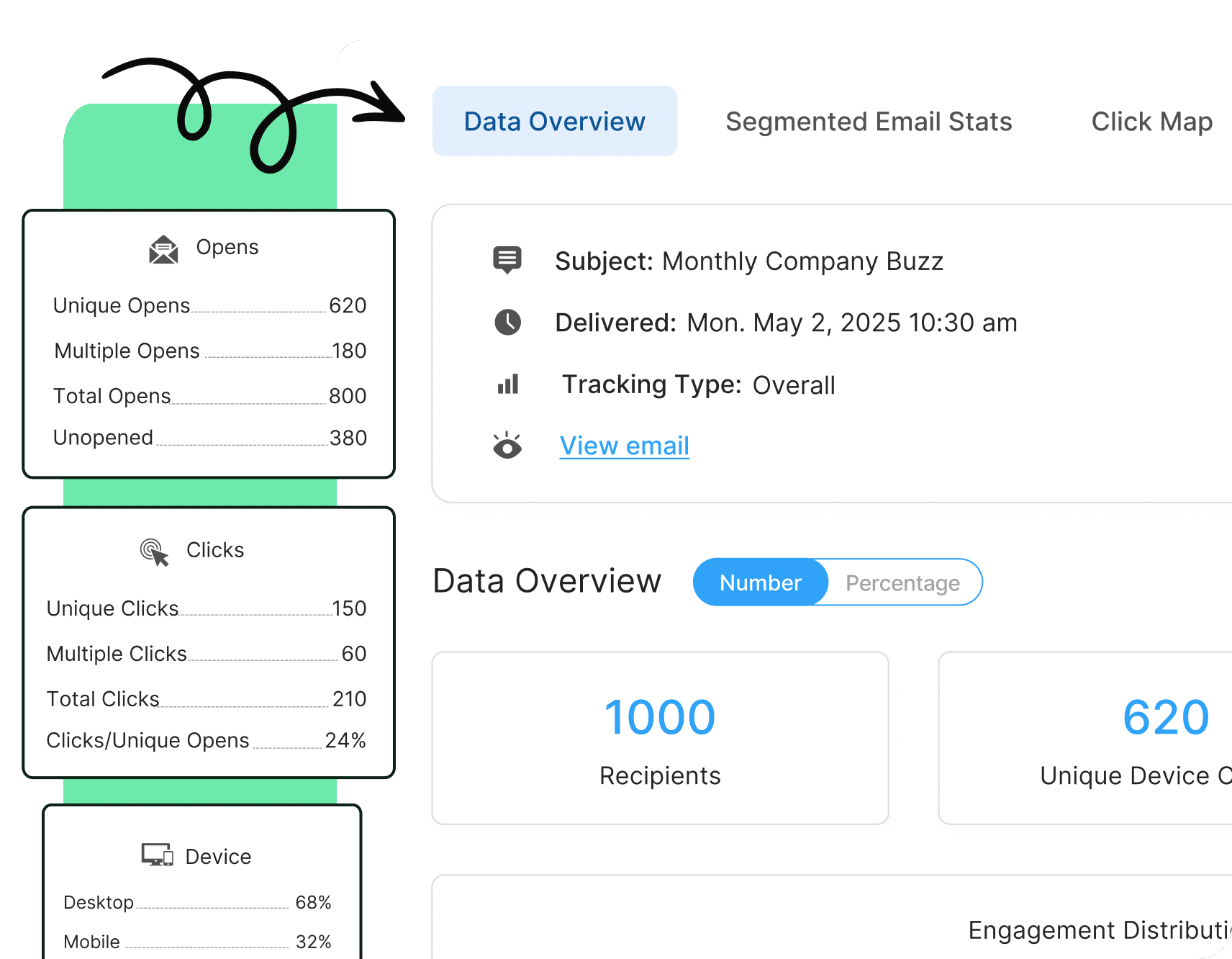
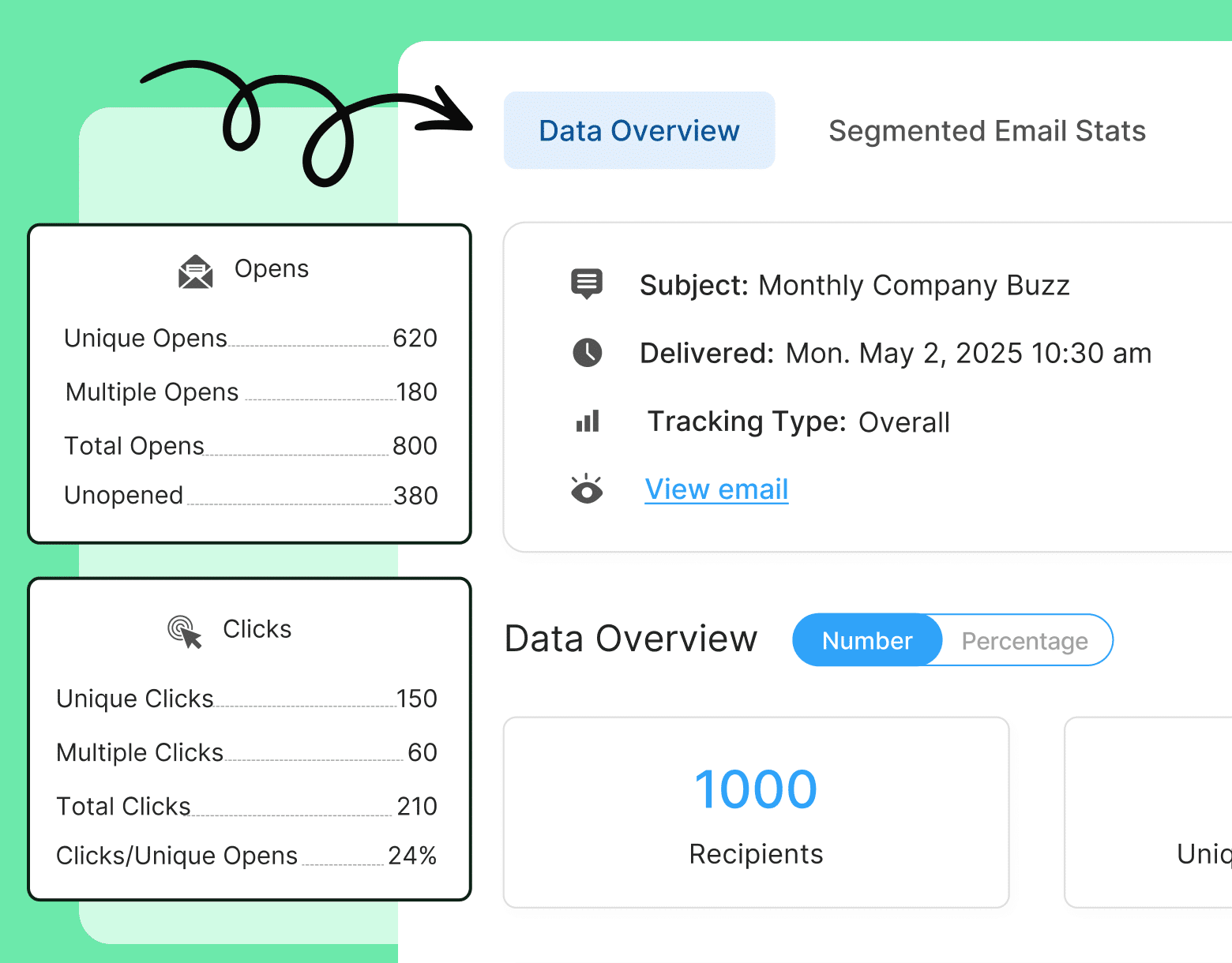
9. Leverage preheader text
Preheader text is the snippet of copy that appears next to or beneath your subject line. Utilize it wisely to tease your content and encourage opens.
Why it works to improve internal email engagement: A compelling preheader offers added context or a quick benefit statement, making employees more likely to open.
Tips to execute:
- Match the tone of your subject line.
- Offer a sneak peek of what’s inside.
- Limit it to around 40–60 characters for best visibility.
Actionable example: Subject line: “Exciting Department Updates,” Preheader: “Find out how these changes accelerate your career growth.”
Considerations: Don’t duplicate the subject line exactly. Treat the preheader as bonus real estate to further improve internal email engagement.
10. Enrich emails with visuals
Break up walls of text with relevant visuals—images, GIFs, or short videos. This approach keeps employees’ attention and can explain complex topics more clearly.
Why it works to improve internal email engagement: Eye-catching visuals capture attention quickly, increasing the likelihood that employees will read and respond to your message.
Tips to execute:
- Ensure images are compressed for fast loading.
- Use consistent branding to maintain a professional look.
- Combine visuals with short, concise text for clarity.
Actionable example: Feature a short one-minute tutorial video explaining a new software feature instead of lengthy text instructions.
Considerations: Offer accessibility by adding alt text for images or transcripts for videos.
11. Focus on value-add content
No matter how visually appealing your emails are, employees will lose interest if the content isn’t genuinely helpful. Every message should serve a clear purpose and offer real value.
Why it works to improve internal email engagement: Employees learn to recognize that your communications have meaningful insights, tips, or updates, boosting trust and improving employee email engagement.
Tips to execute:
- Align content with ongoing projects or strategic goals.
- Provide resources, tutorials, or exclusive event invites.
- Share departmental wins or success stories.
Actionable example: A weekly “Team Win Wednesday” email highlights achievements across departments, promoting collaboration and interest.
Considerations: Double-check each email’s relevance before sending. If it’s not valuable, employees may quickly tune out.
Watch ContactMonkey LIVE in action
Join live demo
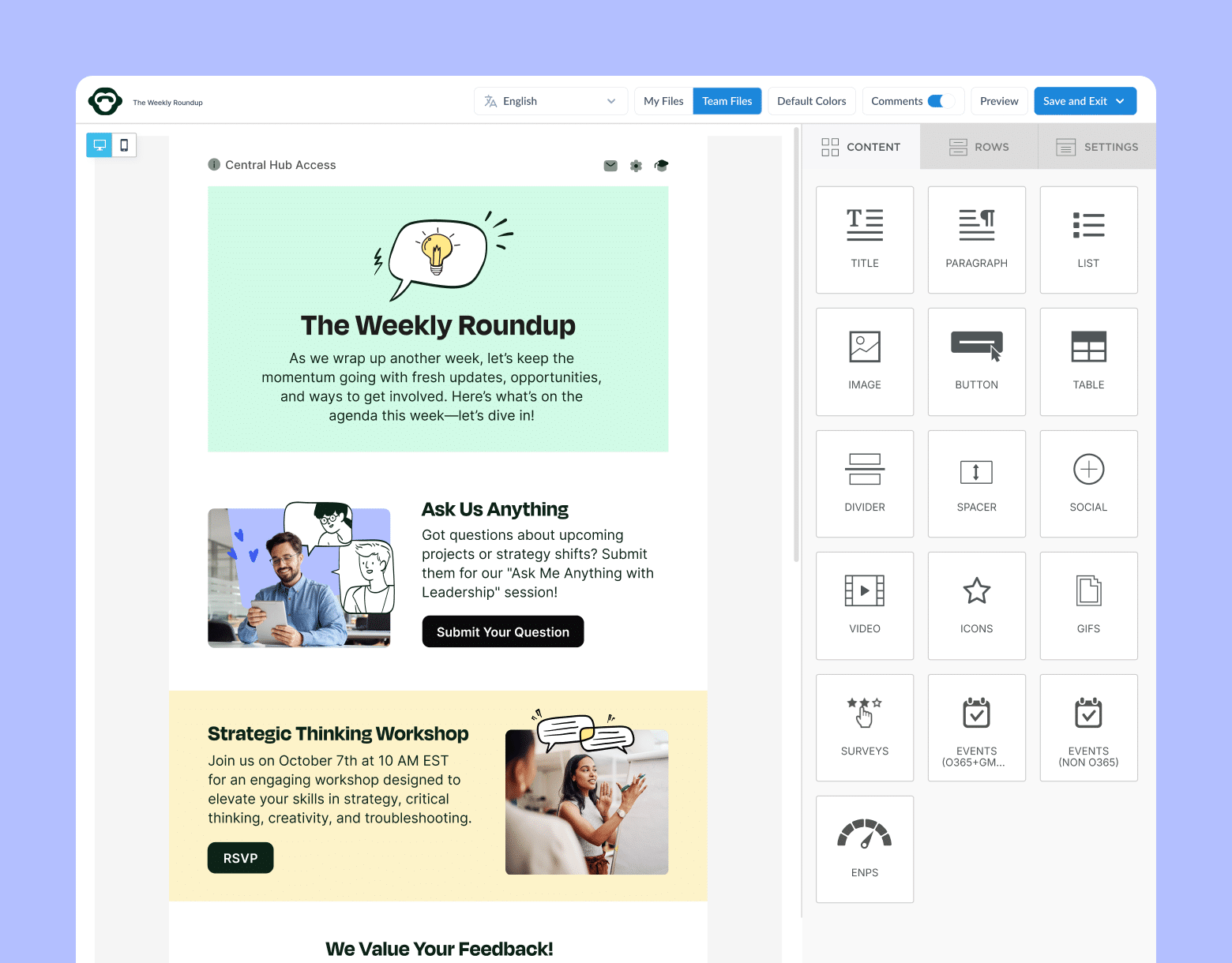
12. Build in two-way dialogue
Internal emails shouldn’t always be one-way announcements. Encourage employees to reply with questions, ideas, or feedback for higher internal email engagement.
Why it works to improve internal email engagement: When employees feel heard, they’re more likely to stay engaged and open future messages—helping you sustain improving internal email engagement rates over time.
Tips to execute:
- Include a direct “Reply to This Email” invitation.
- Pose a question or a brief poll.
- Acknowledge and share responses in follow-up communications.
Actionable example: “Have ideas for our next product launch? Reply directly to this email—we’d love to feature your suggestions in next week’s update!”
Considerations: Have a process in place to handle and respond to incoming feedback promptly.
🎁BONUS: Our employee feedback survey how-to guide will explain what you need to know to gain valuable insights from your employees.
13. Keep messages brief and scannable
Long emails filled with dense text may push employees to skim or ignore them altogether. Brief, structured messages increase employee email engagement by making it easier to absorb information quickly.
Why it works to improve internal email engagement: Employees appreciate clarity and brevity. If key points are easy to spot, they’re more likely to read the entire message.
Tips to execute:
- Use bullet points or short paragraphs.
- Highlight deadlines or important updates in bold.
- Provide links to deeper resources for those needing more info.
Actionable example: A quick, bulleted list of updates with clear headings, followed by “For full details, click here” to keep the main email concise.
Considerations: Balance brevity with completeness. Don’t omit critical information employees need to do their jobs.

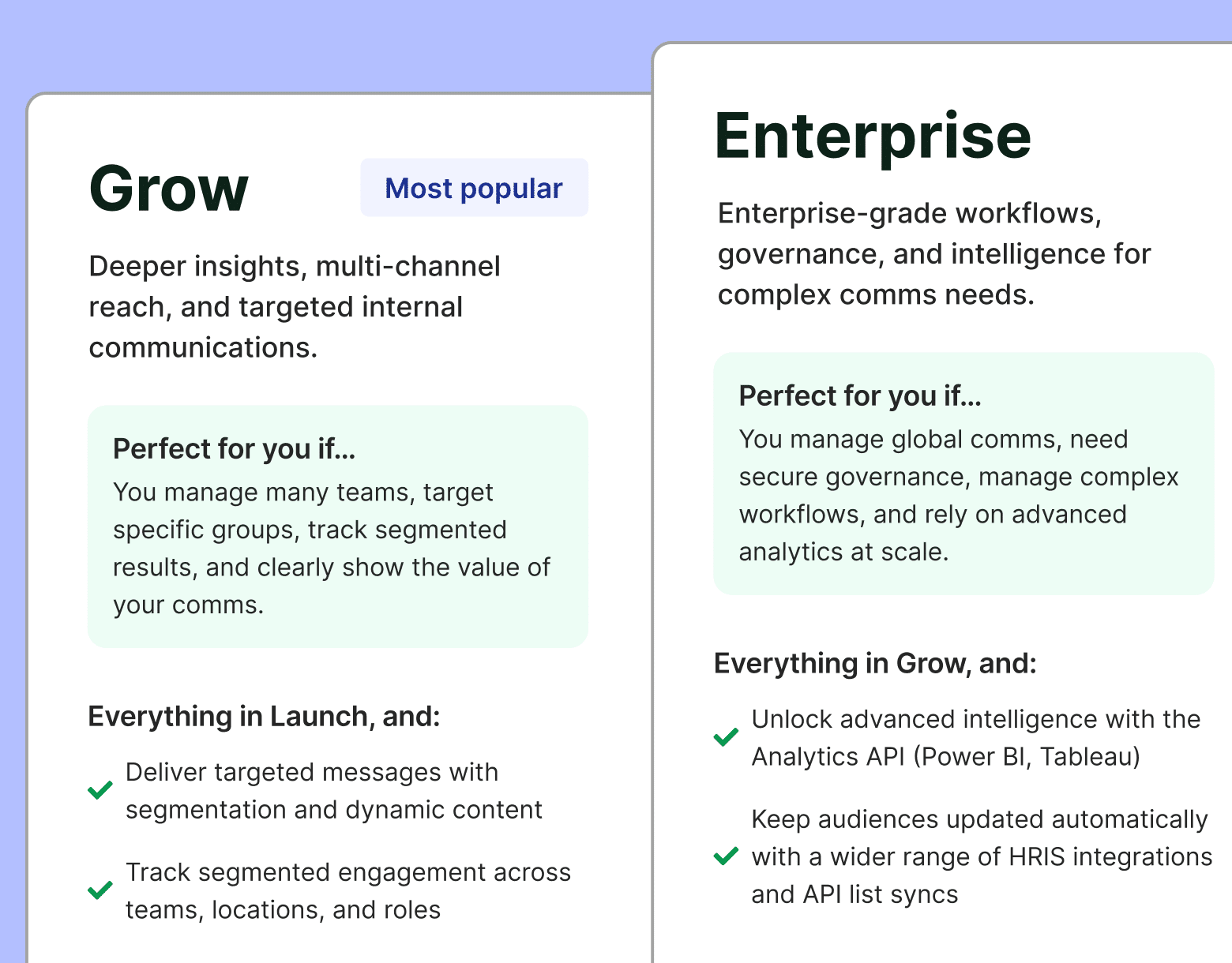
14. Schedule emails strategically
Not all times of day or week are equal when it comes to employee email engagement. Sending important news late on a Friday might bury it, while Monday morning might be too chaotic.
Why it works to improve internal email engagement: Timing your sends to when employees are most attentive increases open and click-through rates, directly improving internal email engagement.
Tips to execute:
- Look at historical open data to find peak engagement.
- Consider time zones for remote or global teams.
- Avoid known busy periods (e.g., end of quarter, major deadlines).
Actionable example: If your marketing team shows high opens around 10 AM on Tuesdays, schedule your campaign updates for that day and time.
Considerations: Monitor metrics after each send to refine your schedule. Priorities and workflows can shift.
15. Track performance and gather feedback
Finally, consistent measurement is essential for improving internal email engagement. Reviewing analytics like open rates, click-throughs, and read time guides you toward effective tweaks and refinements.
Why it works to improve internal email engagement: Data-driven insights reveal which messages resonate with employees and which fall flat, helping to measure engagement rates and make iterative improvements.
Tips to execute:
- Monitor internal email engagement metrics like opens, clicks, and link activity.
- Solicit direct feedback with short pulse surveys.
- Compare results to internal email engagement benchmarks to measure progress.
Actionable example: If a certain campaign underperforms, conduct a quick poll in your next email to ask employees what they’d like to see improved.
Considerations: Use data ethically and transparently. Let employees know their feedback is anonymous if you promise confidentiality.
🐒 PRO TIP: ContactMonkey’s analytics dashboard feature displays in-depth internal email engagement KPIs like open and click rates in real-time, showcasing how to measure internal email engagement. This data guides you toward internal email engagement best practices and more impactful communications.
How to Measure Internal Email Engagement
Learning how to measure internal email engagement is key to refining your approach and confirming your results. Most modern email platforms, including specialized internal communication tools, offer robust analytics that show you internal email engagement metrics such as open rate, click-through rate, and time spent reading each email. Here are a few key items to look at:
- Open rate: Shows how many employees opened your email out of the total recipients.
- Click-through rate (CTR): Tracks how many times links or CTAs within your email were clicked.
- Conversion rate: Indicates how many employees completed the action you requested (e.g., filling out a form, scheduling a meeting).
- Read time: Analyzes how long employees spent reading the email.
When you consistently monitor these internal email engagement KPIs, you can see where your strategy is succeeding and where it needs improvement. If you notice an area that consistently struggles—like low CTR—consider A/B testing different elements (CTAs, visuals, or subject lines) to see which variation drives better outcomes.
Finally, don’t forget to solicit direct feedback from employees. Send out a simple pulse survey or poll after major internal email engagement campaigns to find out if employees find the content valuable. By measuring internal email engagement rates both quantitatively and qualitatively, you can gather insights that feed into ongoing improvement cycles.
How ContactMonkey Improves Internal Email Engagement
By investing in an advanced internal comms platform, you access a range of tools and features to boost internal email engagement. This includes:
- Comprehensive tools for consistent engagement: ContactMonkey combines user-friendly design, targeted distribution, and robust analytics—giving you everything you need to consistently improve internal email engagement.
- Fine-tuned messaging capabilities: Tap into features like segmentation, in-email feedback, and real-time performance data to refine every aspect of your communications for maximum impact.
- Data-driven insights: This analytical approach supports vital internal email engagement metrics, provides a transparent view of engagement trends, and keeps you aligned with internal email engagement best practices.
- Personalization and testing made simple: Whether you’re looking to boost employee email engagement through personalization, sharpen your content strategy with A/B testing, or gain deeper insights into message performance, ContactMonkey has you covered.
- A powerful ally for higher engagement rates: Across departments and teams, ContactMonkey proves to be a reliable partner for improving internal email engagement rates in every corner of your organization.
So, what’s keeping you from accessing results? Book a FREE demo with one of our experts to explore how you can improve internal email engagement at your organization!



